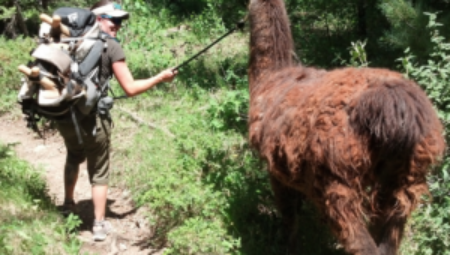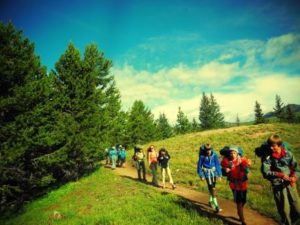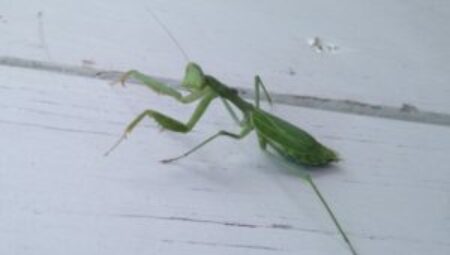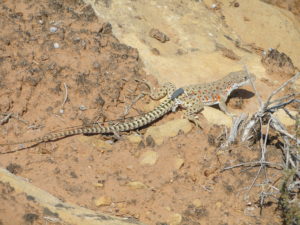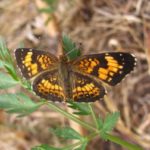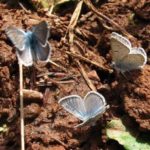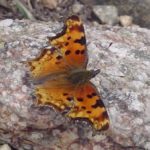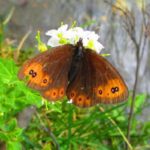The Next Generation of Wilderness Defenders
“Shoo!” “Scram!” “Oooogaboogaboogaboo!”
The Wilderness Information Specialists (WIS’s) in training started throwing rocks at a hollow log. The sound startled the mountains goats and they ran away. We rejoiced! We had chased the mountain goats out of our camp.
Any nature savvy individual knows that harassing wildlife is a faux pas. It stresses the animals and can scare them away from water or forage thus leaving them in a weakened state and more prone to predation. But the mountain goats in Chicago Basin are NOT afraid. The love us. They want to get as close as they can. Why?
Mountains goats normally live above treeline (~12,000’ in SW Colorado) but in Chicago Basin in the Weminuche Wilderness, goats can be spotted as low as 10,500’. They have moved lower to be closer to the salt people leave behind – especially our urine. Goats will destroy vegetation in order to get at the salty urine. Therefore, it is important for visitors to urinate on rocks or logs.
And that is just one iota of what folks should know before visiting “The Basin”. There are volumes of information regarding the 4 W’s: Water, Weather, Wildlife, and Waste.
But how is a visitor supposed to know all this stuff? There are plenty of resources available online (search for SJMA’s “Chicago Basin Trip Planning Guide”), by phone, and at the trailhead. But if a visitor gets all the way to The Basin without proper knowledge, a WIS there can explain proper etiquette and why it matters.
On July 19 – 21, another guide and I took a group of six local teenagers to The Basin as WIS’s in training. Before the trip, the teen WIS’s had to complete an online training and test. This included general information about the Wilderness Act, Wilderness regulations, and a list of FAQ’s specific to Chicago Basin. By the start of the trip, these kids were ready! We hopped the Durango-Silverton train to Needleton. We began educating hikers and backpackers before we even got off the train. It took some prodding at first to get the teens to approach visitors, but by the third day the folks hiking in could barely get past them without receiving an onslaught of Wilderness information. The teens were nearly talking over each other to be sure that their information was heard. We talked to 91 visitors over three days!
What was their information?
- Weather: From July into September, afternoon lightning storms are a real threat. Be off the high summits by noon. Keep an eye to the sky and seek cover if the clouds look ominous.
- Water: Treat your drinking water in order to protect from the parasites giardia and cryptosporidium. Avoid getting water from sources contaminated by mines. Look for aquatic macroinvertebrates living in the water – this is a good sign. Also, camp at least 100’ from any water sources in order to avoid compacting riparian soil and prevent scaring wildlife away from their drinking water.
- Waste: Pack out all your trash INCLUDING TOILET PAPER. Critters will dig up buried toilet paper. There are natural items that can serve as toilet paper. Pack out your human waste or bury it 6 to 8 inches underground at least 200’ from any water sources.
- Wildlife: In addition to the mountains goats, be prepared to keep your food and salty gear away from marmots, chipmunks, bears, and moose. Store salty gear (packs, poles, shoes, clothes) at least 5 feet up a tree or in an enclosed tent. When not in camp, store all food at least 10 feet up and 5 feet out.
- No campfires are allowed in the Needle Creek watershed.
- No mechanized or motorized use is allowed in designated Wilderness, including drones.
- Most importantly, this isn’t just a list of regulations to ruin your fun. This is public land that is here for all of us to enjoy. We need to work together to keep it pristine for ourselves and future generations. In designated Wilderness, “man is a visitor who does not remain”. Wilderness is nature in its natural state.
 It’s no secret that public lands are under fire right now. But here at the San Juan Mountains Association, we are training the next generation how to educate others to take care of these treasures that belong to all of us. This was the 5th annual teen backpacking trip and I assure you that there will be more to come.
It’s no secret that public lands are under fire right now. But here at the San Juan Mountains Association, we are training the next generation how to educate others to take care of these treasures that belong to all of us. This was the 5th annual teen backpacking trip and I assure you that there will be more to come.
- Published in Backpacking, Hiking, Nature
By MK Gunn
Not every adventure goes according to plan, but if it is not planned, the adventure might never go.
This is the sentiment that occurred to me, not all at once, at some point in college. I was, and still try to be, of the spontaneous sort. I don’t mind a good flying by the seat of my pants. Life should be filled with magic and serendipity. It should be a “choose your own adventure” book – you don’t know what life has in store for you next until you turn the page.
But adventure and spontaneity 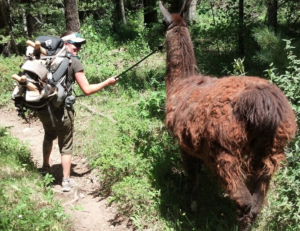 still require a catalyst. And often, that catalyst is the inkling of a plan.
still require a catalyst. And often, that catalyst is the inkling of a plan.
I first moved to Durango as a clueless 19-year-old. I was certain of very few things. I knew that I loved the mountains, didn’t like school and needed to stay in school because I had no idea what I wanted to do with my life besides go mountain biking and snowboarding.
I arrived in Colorado with most of the proper equipment and waited for the spontaneity to happen. And, to be fair, there certainly was some adventure. I was smart enough to join the Fort Lewis College mountain bike team, which took me traveling all over my new state. I saw new mountain ranges. Explored new towns. Fell in love with new trails. And did some really stupid, fun, irresponsible things.
But these were not my adventures. I was just a follower; a participant. I was not driving my own life … just along for the ride. If no one else was doing the planning, I rarely went farther than the trails behind my apartment. Was this what spontaneous and magical adventure was?
At some point, the fog lifted from my young brain. If I wanted to really choose my own adventure, I had to stimulate the catalyst. I had to start planning.
This wasn’t a lucid thought but rather a long, largely unnoticed transformation. Really, one day I turned around and there I was – the reluctant leader of our next adventure. If you want something done, you have to do it yourself. My life was transformed.
I never make any promises to my followers. My cheesy but true motto has become, “It’s always an adventure with MK.” I frequently find myself amid misadventure, whether it be some unintentional, miserable bushwhack or up some gully that is too steep to ascend without climbing equipment or on a slickrock pinnacle in a snowstorm. I’ve been caught in lightning storms above tree line, topped out rock climbs after dark and gotten lost far from camp in the middle of a multiday trip. I’ve broken trail in 3 feet of snow, burned a hole in my pants trying to smoke out mosquitoes and carried a sick llama’s saddle on my back. I’ve broken bones, torn tendons, compromised cartilage, jostled joints and skewered skin. All with no regrets. I can’t tell you how many times I’ve been in the thick of a major mishap and thought to myself, “This is going to make a great story if I ever get out of here.”
 You see, the reason I never enjoyed planning when I was younger is that nothing is ever quite as exciting when it goes according to plan. Spontaneity and serendipity are forms of art. Planning seems to lend itself to the exactness of science. To be clear, I have nothing against the sciences: I am fully committed to the laws of physics, intrigued by the growth and function of living organisms and even teach science to folks via outdoor education.
You see, the reason I never enjoyed planning when I was younger is that nothing is ever quite as exciting when it goes according to plan. Spontaneity and serendipity are forms of art. Planning seems to lend itself to the exactness of science. To be clear, I have nothing against the sciences: I am fully committed to the laws of physics, intrigued by the growth and function of living organisms and even teach science to folks via outdoor education.
Despite planning’s potential for boring exactness, it could lead to the art of misadventure. Nowadays, knowing that not every adventure goes according to plan but if it is not planned the adventure might never go, I am obsessed with planning new adventures. Some I plan an hour before, some months in advance. Here in the San Juan Mountains, my favorite season is what I call clear tundra season – the time of year when the tundra is snow-free. So I have this planned out months ahead of time. If you want me to set aside a day in July, you should have asked me last year.
What’s my point? Here’s an example: My husband and I spent months planning to hike the Colorado Trail. We had an exact time line, including daily mileages and camp spots, boxes of meticulously portioned food, friends lined up to help with resupplies and contingency plans if we needed to send our dogs home early (which we did). We were grateful for such a fastidious plan. Our resupplies went flawlessly. Having a daily mileage goal kept me motivated. We finished on the exact date we had planned and had a day to recover afterwards. But those were not the exciting parts of the trip. The excitement still came from the unexpected wonders and misadventures along the way.
Ten days into the trip, along the West Collegiate route, we came across a sign telling us that we could detour onto a 26 mile reroute that contained 20 miles of new single track on the Continental Divide. The old route consisted of dirt roads and motorized double track. Any adventurous soul would have opted for the mapless reroute. For two days, we would not be certain of where we could find water or if there was a good camp. But within 2 miles, we saw out first moose of the trip. We slept on the Continental Divide that night in a flattish  depression out of the wind. The next day, we were caught in a lightning storm above tree line at 9 in the morning. We pulled our tent over us and hunkered down right there in the open. I can assure you, it’s not scary when it’s actually happening because there is absolutely nothing you can do. And the lakes, flowers, mountains and pikas seemed slightly more wonderful on this mysterious path. There was more excitement on this unknown, unplanned way. We were flying by the seats of our pants.
depression out of the wind. The next day, we were caught in a lightning storm above tree line at 9 in the morning. We pulled our tent over us and hunkered down right there in the open. I can assure you, it’s not scary when it’s actually happening because there is absolutely nothing you can do. And the lakes, flowers, mountains and pikas seemed slightly more wonderful on this mysterious path. There was more excitement on this unknown, unplanned way. We were flying by the seats of our pants.
So, please make a plan. Make a good plan. If nothing else, remember the six P’s: proper planning prevents piss poor performance. Use scientific tools to check the weather forecast. You can even plan to explore geologic structures and treat your water with scientifically proven methods. But even the most exact of science is susceptible to the occasional chaos. Sometimes, a catalyst might disrupt the normally predictable into a whirl of serendipitous wonder. Or, you might have to hike home with duct tape and p-cord holding your shoe together.
MK Gunn is the education and program assistant for San Juan Mountains Association. Her book of short stories, Zero Chance of Rain and other Tales of Misadventure, is due out in 2018. She implores you to expect the unexpected.
- Published in Backpacking, Hiking, Nature, Uncategorized
Linking Lynx and Lodgepole Pines
There is a lot of negative talk these days about human planted non-native species. Burmese pythons that were once household pets are wiping out the small animal population in parts of Florida in part because they have no predators to control their population. The tamarisk bush is decimating the native cottonwood and willow populations of the Southwest U.S. by adding alkalinity to the soils. In the Northeast and other parts of the U.S., purple loosestrife, a pretty flower that holds together river banks, is taking the place of cattails – a popular bird food and habitat. The list goes on and on.
With all these stories of humans inadvertently wreaking havoc on the natural environment, how about a story of hope? Once in a while, a non-native species can actually have a positive effect on the environment. Read on for a success story right here in Southwest Colorado.
Lodgepole pines are native in Colorado and are mostly found on the Front Range in areas such as Rocky Mountain National Park and Summit County. (Lodgepoles are a type of pine widely decimated by pine beetles.) However, lodgepole pines are not native to Southwest Colorado. There is a large area of these pines between Coal Bank and Molas passes along US highway 550and the story about how they got there is interesting.
Back in 1879, there was a major forest fire in that area. It was named the Lime Creek burn because of its vicinity to Lime Creek. It was assumed that the area would regenerate naturally as do many forests after a fire. It did not. To this day, burned out stumps from this fire can be seen along the Colorado Trail heading west from Little Molas Lake. Some stand like sentinels in the high open meadows along the trail.
In the early 1900’s there was some concern about the lack of regrowth. Many trees were replanted including lodgepole pines. Some thought that the non-native pines would give way to native subalpine fur and Engelmann spruce, but that never happened. The pines thrived and multiplied.
Fortunately, lodgepole pines do not have some of the mechanisms to take over other plants the way tamarisk or purple loosestrife do. In fact these lodgepole pines have helped an animal on the U.S. Fish and Wildlife Service’s threatened species list – the Canada lynx.
The Story of the Lynx in Southwest Colorado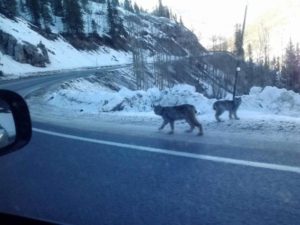
Canada Lynx are wild cats that thrive in the snow. Their range covers much of Alaska and Canada as well as parts of the Northern U.S. Lynx can often be confused with bobcats although there are subtle differences. Lynx are usually larger than bobcats and are not as spotted. Their tails generally have a solid black tip and their ear tufts can be as large as the ears themselves. Lynx have large feet that act as snowshoes and are specially adapted to keep them somewhat on top of the snow. The favorite food of the lynx is the snowshoe hare although it will also eat carrion, ground-dwelling birds such as grouse and ptarmigan, and small mammals like mice and voles. A lynx can spot a mouse 250 feet away!
The lynx, much like other beautifully furred mammals of Colorado, were hunted nearly to extinction in the state. It is thought that the lynx may have disappeared from Colorado around 1973 mostly due to being trapped for their fur as well as habitat destruction. However, in 1999 a reintroduction program started to get a population going in the San Juan Mountains. By 2005, 200 lynx had been released, and kittens were even being born! It is only through reintroduction, careful monitoring and a chance lodgepole pine replanting that lynx are beginning to thrive again in Southwest Colorado.
Snowshoe Hares – the Links to Survival
At this point you may be wondering what the connection is between lynx and lodgepole pines. The links (no pun intended) are snowshoe hares.
Snowshoe hares are a major food source for the lynx. Lynx will eat other small mammals, but the hares are preferred. Interestingly, lynx populations are so dependent on 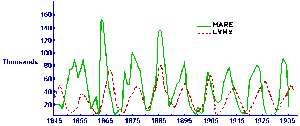 snowshoe hares that when the hare population decreases, so does the lynx’s. This cycle occurs about every 10 years. The evidence is astounding for this relationship.
snowshoe hares that when the hare population decreases, so does the lynx’s. This cycle occurs about every 10 years. The evidence is astounding for this relationship.
Snowshoe hares love to feed on lodgepole pine needles in the winter. They prefer this food source over other available conifers. There are a number of statements to support the snowshoe hare’s love of lodgepole pines as a food source in a report published by the US Forest Service. (Click here: http://www.fs.fed.us/database/feis/animals/mammal/leam/all.html ) Mainly,” Winter snowshoe hare pellet counts were highest in 20-year-old lodgepole pine stands, lower in older lodgepole stands, and lowest in spruce-dominated stands” and “In British Columbia overstocked juvenile lodgepole pine (Pinus contorta) stands formed optimal snowshoe hare habitat”.
So, back in the aftermath of the Lime Creek Burn, who would have ever suspected this result? Lynx were not even endangered at the time of the replanting. Also, it was expected that the lodgepole pines would be taken over by the other trees. It was really just a happy accident. In winter 2012, retired National Park Service employee Steve Chaney, photographed two lynx from the window of his car on Molas Pass in the San Juan National Forest. So, be on the lookout for these fine and resilient felines the next time you are driving, hiking, or otherwise recreating in the Coal Bank and Molas Pass area. If nothing else, you may see a snowshoe hare!
Field and Classroom Activities
Field Trip: Visit the Lime Creek Burn Area: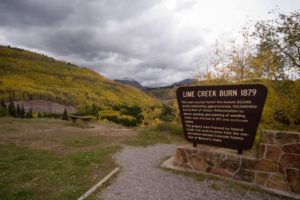
Get the kids outside to see the lodgepole pines in the Lime Creek Burn Area.
– The Coal Creek Trail ascends through the lodgepole pines. Although it is a generally steep trail, the lower portion is not too bad.
– An informational sign about the fire is located along the east side of the highway.
– Be on the lookout for lynx and snowshoe hare!
Outdoor Activity: Oh Deer!
Taken From: http://www.projectwild.org/documents/ohdeer.pdf)
Grade Level: 5–8
Subject Areas: Science, Environmental Education, Mathematics, Expressive Arts
Duration: one 30- to 45-minute session
Group Size: 15 and larger recommended
Setting: indoors or outdoors; large area for running needed
Key Terms: habitat, limiting factors, predator, prey, population, balance of nature, ecosystem
Objectives: Students will (1) identify and describe food, water, and shelter as three essential components of habitat; (2) describe factors that influence carrying capacity; (3) define “limiting factors” and give examples; and (4) recognize that some fluctuations in wildlife populations are natural as ecological systems undergo constant change.
Method: Students portray deer and habitat components in a physical activity.
Materials: An area—either indoors or outdoors—large enough for students to run (e.g., playing field), chalkboard or flip chart, writing materials
Background
Carrying capacity refers to the dynamic balance between the availability of habitat components and the number of animals the habitat can support. A variety of factors related to carrying capacity affect the ability of wildlife species to successfully reproduce and to maintain their populations over time. The most fundamental of life’s necessities for any animal are food, water, shelter, and space in a suitable arrangement. Without these essential components, animals cannot survive.
However, some naturally caused and culturally induced limiting factors serve to prevent wildlife populations from reproducing in numbers greater than their habitat can support. Disease, predator and prey relationships, varying impacts of weather conditions from season to season
(e.g., early freezing, heavy snows, flooding, drought), accidents, environmental pollution, and habitat destruction and degradation are among these factors. An excess of such limiting factors leads to threatening, endangering, and eliminating whole species of animals.
This activity illustrates that:
• good habitat is the key to wildlife survival,
- a population will continue to increase in size until some limiting factors are imposed,
- limiting factors contribute to fluctuations in wildlife populations, and
- nature is never in “balance,” but is constantly is changing. Wildlife populations are not static. They continuously fluctuate in response to a variety of stimulating and limiting factors. We tend to speak of limiting factors as applying to a single species, although one factor may affect many species. Carrying capacity limitations can result in competition among domestic animals, wildlife, and humans. Natural limiting factors, or those modeled after factors in natural systems, tend to maintain populations of species at levels within predictable ranges. This kind of “balance in nature” is not static but is more like a teeter-totter than a balance. Some species fluctuate or cycle annually. Quail, for example, may start with a population of 100 pairs in early spring, grow to a population of 1,200 birds by late spring, and decline
slowly to a winter population of 100 pairs again. This cycle appears to be almost totally controlled by the habitat components of food, water, shelter, and space, which are also limiting factors. Habitat components are the most fundamental and the most critical of limiting factors in most natural settings. This activity is a simple but powerful way for students to grasp some basic concepts: first, that everything in natural systems is interrelated; second, that populations of organisms are continuously affected by elements of their environment; and third that populations of animals are continually changing in a process of maintaining dynamic equilibrium in natural systems.
Procedure
- Tell students they will be participating in an activity that emphasizes the most essential things animals need in order to survive. Review the essential components of habitat with the students: food, water, shelter, and space in a suitable arrangement. This activity emphasizes three of those habitat components—food, water, and shelter—but the students should not forget the importance of the animals having sufficient space in which to live, and that all the components must be in a suitable arrangement for wildlife populations to reach their maximum size.
- Ask the students to count off in fours. Have all the ones go to one area; all twos, threes, and fours go together to another area. Mark two parallel lines on the ground or floor 10 to 20 yards apart. Have the ones line up behind one line; the rest of the students line up behind the other line, facing the ones.
- The ones become “deer.” All deer need good habitat to survive. Again ask the students what the essential components of habitat are
(food, water, shelter and space in a suitable arrangement). For this activity, assume that the deer have enough space in which to live.
The deer (the ones) need to find food, water, and shelter to survive. When a deer is looking for food, it should clamp its “hooves” over its
stomach. When it is looking for water, it puts its “hooves” over its mouth. When it is looking for shelter, it holds its “hooves” together over its head. A deer can choose to look for any one of its needs during each around or segment of the activity;
the deer cannot, however, change what it is looking for (e.g., when it sees what is available during that round). It can change what it is looking for in the next round,
if it survives.
- The twos, threes, and fours are food, water, and shelter—components of habitat.
Each student is allowed to choose at the beginning of each round which component he or she will be during that round. The students depict which component they are in the same way the deer show what they are looking for (i.e., hands on stomach for food, and so on).
- The activity starts with all players lined up behind their respective lines (deer on one side, habitat components on the other side)—and with their backs facing the students along the other line.
6. Begin the first round by asking all of the students to make their signs—each deer
deciding what it is looking for, each habitat component deciding what it is. Give the students a few moments to put their hands in place—over stomachs, over mouths, or over their heads. (The two lines of students normally will display a lot of variety—with some students portraying water, some food, and some shelter. As the activity proceeds, sometimes the students confer with each other and all make the same sign. That’s okay.
- When the students are ready, say, “Oh Deer!” Each deer and each habitat component turn to face the opposite group, continuing to hold their signs clearly.
- When deer see the habitat component they need, they should run to it. Each deer must hold the sign of what it is looking for until getting to the habitat component student with the same sign. Each deer that reaches its necessary habitat component takes the “food,” “water,” or “shelter” back to the deer
side of the line. “Capturing” a component represents the deer successfully meeting
its needs and successfully reproducing as a result. Any deer that fails to find its food, water, or shelter dies and becomes part of the habitat. That is, any deer that died will be a habitat component in the next round and so is available as food, water, or shelter to the deer that are still alive. NOTE: When more than one deer reaches a habitat component, the student who arrives there first survives. Habitat components stay in place until a deer chooses them. If no deer needs a particular habitat component during a round, the habitat component just stays where it is in the habitat. The habitat component can, however, change which component it is from round to round.
- Record the number of deer at the beginning of the activity and at the end of each round. Continue the activity for approximately 15 rounds. 10. At the end of the 15 rounds, bring the students together to discuss the activity.
Encourage them to talk about what they experienced and saw. For example, they saw a small herd of deer (7 students in a class size of 28) begin by finding more than enough of its habitat needs. However, because the population of deer expanded over two to three rounds of the activity until it exceeded the carrying capacity of the habitat, there was not sufficient food, water, and shelter for all
members of the herd. At that point, deer starved or died of thirst or lack of shelter,
and they returned as part of the habitat. Such things happen in nature also. NOTE: In real life, large mammal populations might also experience higher infant mortality and lower reproductive rates.
11.Using a flip chart pad or chalkboard, post the data recorded during the activity. The number of deer at the beginning of the activity and at the end of each round represents the number of deer in a series of years. That is, the beginning of the activity is year one; each round is an additional year. Deer can be posted by fives for convenience. For example, the students will see this visual reminder of what they experienced during the activity: the deer population fluctuated over a period
of years. This process is natural as long as the factors that limit the population do not become excessive to the point where the animals cannot successfully reproduce. The wildlife populations will tend to peak, decline, and rebuild; peak, decline, and rebuild—as long as there is good habitat and sufficient numbers of animals to reproduce successfully, although do not encourage it. For example, all the students in habitat might decide to be shelter. That could represent a drought year with no available food or water.) NOTE: Switching symbols in the middle of
a round can be avoided by having stacks of three different tokens—or pieces of colored paper—to represent food, water, and shelter at both the habitat and deer ends of the field. At the start of each round, players choose one of the symbols before turning around to face the other group.
12.What is realistic and unrealistic about this simulation? (Deer that do not survive
Do become recycled as nutrients but it is not instantaneous. Deer need all habitat components to survive. Poor habitat usually results in a weakened individual that succumbs to disease, not instant death.)
- In discussion, ask the students to summarize some of the things they learned from this activity. What do animals need to survive? How do these components influence carrying capacity? What are some “limiting factors” that affect the survival of animals? How do factors that limit carrying capacity affect the health, numbers, and distribution of animals? How do these factors affect competition within a species? Why is good habitat important for animals? Are wildlife populations static
, or do they tend to fluctuate as part of an overall “balance” of nature? Is nature ever really in “balance” or are ecological systems involved in a process of constant change?
Indoor Activity: Predator-Prey Models: Canadian Lynx and Snowshoe Hares
(Taken from https://www.math.duke.edu//education/ccp/materials/diffeq/predprey/pred1.html)
In the study of the dynamics of a single population, we typically take into consideration such factors as the “natural” growth rate and the “carrying capacity” of the environment. Mathematical ecology requires the study of populations that interact, thereby affecting each other’s growth rates. In this module we study a very special case of such an interaction, in which there are exactly two species, one of which — the predators — eats the other — the prey. Such pairs exist throughout nature:
- lions and gazelles,
- birds and insects,
- pandas and eucalyptus trees,
- Venus fly traps and flies.
To keep our model simple, we will make some assumptions that would be unrealistic in most of these predator-prey situations. Specifically, we will assume that
- the predator species is totally dependent on a single prey species as its only food supply,
- the prey species has an unlimited food supply, and
- there is no threat to the prey other than the specific predator.
Very few such “pure” predator-prey interactions have been observed in nature, but there is a classical set of data on a pair of interacting populations that come close: the Canadian lynx and snowshoe hare pelt-trading records of the Hudson Bay Company over almost a century. The following figure (adapted from Odum, Fundamentals of Ecology, Saunders, 1953) shows a plot of that data. 
To a first approximation, there was apparently nothing keeping the hare population in check other than predation by lynx, and the lynx depended entirely on hares for food. To be sure, trapping for pelts removed large numbers of both species from the populations — otherwise we would have no data — but these numbers were quite small in comparison to the total populations, so trapping was not a significant factor in determining the size of either population. On the other hand, it is reasonable to assume that the success of trapping each species was roughly proportional to the numbers of that species in the wild at any given time. Thus, the Hudson Bay data give us a reasonable picture of predator-prey interaction over an extended period of time. The dominant feature of this picture is the oscillating behavior of both populations.
- On average, what was the period of oscillation of the lynx population?
- On average, what was the period of oscillation of the hare population?
- On average, do the peaks of the predator population match or slightly precede or slightly lag those of the prey population? If they don’t match, by how much do they differ? (Measure the difference, if any, as a fraction of the average period.)
To be candid, things are never as simple in nature as we would like to assume in our models. In areas of Canada where lynx died out completely, there is evidence that the snowshoe hare population continued to oscillate — which suggests that lynx were not the only effective predator for hares. However, we will ignore that in our subsequent development.
Our ‘Spiritual’ Insect Friend, the Praying Mantis
While walking around Hawkins Preserve in Cortez on a recent morning I happened upon an insect that is letting itself be seen more this time of year. I managed to carefully scoop her (or him) up in my hand while she seemed to look at me with curiosity, and took a good look at her perfect little insect body.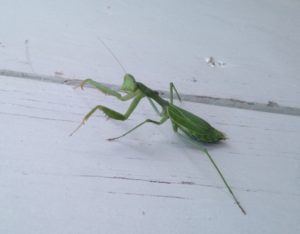
The praying mantis is thus named because of the interesting way it holds its front two legs, looking like they are in a praying position. The word ‘mantis’ actually comes from the Greek ‘mantikos’, meaning prophet. There are over 2,000 species of praying mantids in the world, but only a certain portion of these are actually from the genus ‘mantis’; thus praying ‘mantid’ is usually more correct. Their front legs are used to snag insect prey, and although the mantis may be sold in some garden stores as a beneficial insect, it doesn’t actually discriminate between eating harmful and eating beneficial insects. It will eat a beneficial honeybee just as likely as it will eat a damaging caterpillar.
The praying mantis is also known for its two large compound eyes, adding to its ‘alien-like’ appearance. Less well known, however, are the three simple eyes found between the compound eyes on its triangle-shaped head. The two large eyes enable the mantis to have stereoscopic vision, one of only two insects in the world that have this. The praying mantis is the only insect able to turn its head 180 degrees. Some, but not all, praying mantises have wings. Some praying mantises have one ear, located on their abdomen. It doesn’t hear most sounds very well with this ear, but it is actually able to hear high-pitched bat echolocation ‘peeps’. This enables the mantis to evade bats that are trying to get a midnight snack.
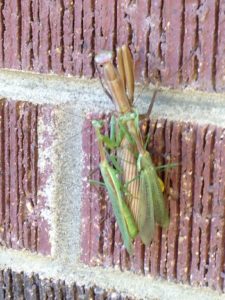 Praying mantises mate in the late summer/early fall, and yes, the rumors are true – the female will sometimes either eat her mate after mating or will even bite his head off in the middle of the act (and the body will finish the job without the head). Although this is much more common in captive mantises than in the wild. Some scientists estimate that wild mantises only cannibalize their mates 25% of the time. Incidentally, since starting to write this article about a week ago, I’ve seen 5 praying mantises in the wild; however, the fourth and fifth ones were a female who at first glance seemed to be holding her mate in her arms lovingly… but in actuality she was enjoying munching on his head! The picture on the left shows a female mantis apparently with 2 mates?!
Praying mantises mate in the late summer/early fall, and yes, the rumors are true – the female will sometimes either eat her mate after mating or will even bite his head off in the middle of the act (and the body will finish the job without the head). Although this is much more common in captive mantises than in the wild. Some scientists estimate that wild mantises only cannibalize their mates 25% of the time. Incidentally, since starting to write this article about a week ago, I’ve seen 5 praying mantises in the wild; however, the fourth and fifth ones were a female who at first glance seemed to be holding her mate in her arms lovingly… but in actuality she was enjoying munching on his head! The picture on the left shows a female mantis apparently with 2 mates?!
A female praying mantis found in the fall may be looking for a location to lay her egg cases called oothecae. She will lay perhaps hundreds of eggs in each ootheca, which initially looks rather soft and foamy, but eventually dries up, looking more like brown styrofoam. The young stay and grow in this case until spring or early summer when they all hatch out at once! The young nymphs that hatch look just like smaller versions of the adults. As the nymphs grow, they will periodically shed their exoskeleton, having a softer exoskeleton that forms underneath, and eventually hardens. They will do this 6 – 9 times before becoming an adult size.
Despite being predators in the insect world, praying mantises are also preyed upon. Spiders, ants, frogs, lizards, and birds are all predators of the praying mantis. Their main defense is camouflage, and some blend in very well – mimicking flowers, leaves, and sticks in their habitat.
Seeing a praying mantis can be considered to be good luck or bad, depending on your culture. Because of the ‘praying’ hands, some Christians say that the praying mantis represents spiritualism or piety, and if found in your home, may mean that angels are watching over you. Some Muslims say that the praying mantis is always facing towards Mecca. However, in Italy, some believe that if a praying mantis looks at you menacingly, it can make you sick, and in Japan, it may even be a foretelling of your death. Personally, I feel lucky any time I get to see one of these amazing insects, and can’t wait to see more.
Backpacking made Easy(er)
Ah, the thrill of the wilderness! The mountain vistas! The serene lakes! The smell of the spruce trees! The aching back and feet! The soggy sleeping bag! Wait… hang on… these things don’t have to go hand in hand when you are backpacking. With thousands of miles under a pack and trips in every month of the year, I’ve learned things the hard way so you don’t have to.
Pack your pack correctly
A properly packed pack can make a huge difference in comfort.
– Least dense items go in the bottom. (Sleeping bag, mat)
– Medium density item go in the middle. (Tent, clothes)
– Densest items go on the top or closest to your back. (Water, fuel, toiletries, tent poles, stakes)
– Compress, compress, compress! A loose load will wobble.
– Avoid strapping items to the outside that might swing around.
– Be sure to keep important items accessible such as snacks, bug spray, and rain gear.
Keep your stuff dry
– Store your sleeping bag and puffy coat in a drybag AND use a pack cover or line your pack with a heavy duty trash bag. This is a good idea for defense against both rain and creek crossings. Don’t think you are so nimble that you will never fall in a creek!
– A lightweight trekking umbrella can be a sanity saver! It’s especially handy when there is intermittent sun and rain. Stopping every five minutes to put on or take off your rain jacket might drive you crazy. An umbrella is also portable shade.
– Dry socks are like gold. Bring a pair of socks that will only be worn in your tent. This makes for dry, happy feet.
Keep your luxury items to a minimum
I have seen some VERY large packs on the trail with some VERY tired hikers beneath them. Once a hiker was carrying full sized camp chairs. He told me that many years ago his backpacking mentor advised him to bring everything that he would need to be comfortable at camp.
I believe the opposite is true. If you have a lighter pack, you will be less fatigued at camp and therefore won’t need as many luxuries. All these little items add up. By the time you pack a hammock, seat, playing cards, umbrella, full tube of toothpaste, too many wet wipes, water bottle full of wine, and mini pillow, you’ve added 7 pounds to your pack.
If you’re not trying to pack super light, a goal weight for your pack for 3 days should be 30 pounds including food and water. This will also help you go farther.
Choose your camp wisely
– Water – Sleeping next to a babbling brook lulls me to sleep and rocks me like a baby all night long. But camping in a deep river valley can be miserable in the morning. The colder air sinks down to the bottom and dew can condense so much that you may wonder, as you greet the crystal blue morning sky, if you slept through a rainstorm. It is amazing how much warmer and dryer things can be just a short ways up slope. You will also be farther from mosquitoes.
– Morning Sun – Higher camps also mean more sunshine. With summer temps in the Colorado mountains regularly dipping into the 40s, a ridge camp can be delightful even if water access is challenging. When choosing a camp, get out your compass to see if you have a clearing where the sun will rise. In early summer, the sun rises in the northeast (51 degrees). At the fall and spring equinoxes, it is due east. If you are brave enough for winter camping, the sun rises in the east southeast in late December (116 degrees). You can calculate exact bearings at http://aa.usno.navy.mil/data/docs/AltAz.php.
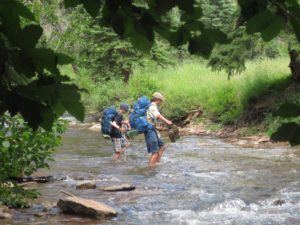 Bring hiking poles
Bring hiking poles
Let your arms help your legs. Some people think that poles are for old people but I think they are for smart people.
Wear your favorite footwear
I’ll spare you from the entire history of backpacking footwear, but 50 years ago, 8 inch high boot tops and rigid boot soles were all the rage. These days, you’ll find folks hiking 500 miles in a pair of trail running shoes or even sandals. The point is, not everyone needs a ton of ankle and foot support. Wear what makes your feet happy. You needn’t wear big heavy boots just because your backpacking mentor told you to.
Author MK Gunn is the education and program assistant for San Juan Mountains Association (sjma.org). She is currently on track to backpack in every month of 2016.
(Picture caption: Well packed packs help you to be more stable.)
- Published in Backpacking, Hiking
Leapin’ Lizards!
One of the neat things about living in Colorado is the ability to see all kinds of lizards in their natural habitat. Lizards are a type of reptile – reptiles also include snakes, crocodiles and alligators, and turtles. Lizards are classified in the phylum Chordata, subphylum Vertebrata, class Reptilia, order Squamata, suborder Sauria. Lizards typically have dry, scaly skin, four feet, claws and a long tail. They can be found in various habitats, including trees (arboreal), underground (fossorial), on the ground (terrestrial), and even sometimes in water (aquatic). Most female lizards lay eggs, although some bear live young. It used to be thought that there were only 2 venomous species of lizard – the Gila monster and the Mexican beaded lizard. Both are found in the Sonoran desert. However, not that long ago scientists discovered that monitor lizards (including Komodo dragons) and some in the Suborder iguania (including some iguanas) have mouth glands that secrete venom.
There are over 3,000 species of lizard in the world, and they are found everywhere except the arctic and Antarctic. Lizards are often fast runners, and some can run up to 15 miles per hour!
Colorado has 19 species of lizards, and most are generally found under 8,000 feet of elevation. This is due to the fact that they are cold-blooded (also called ectothermic), meaning that their body temperature is typically the same as the temperature of their immediate environment. For this reason, you will often find them sunning themselves on a warm rock when the air temperature is cool, and conversely hiding in a cool hole when the air temperature is hot.
Lizards use their tongue to find odors, as snakes do. They are closely related to snakes, but lizards generally have legs, ear openings and eyelids. Lizards have small teeth to bite their prey. Most lizard bites in Colorado will feel like a pinch, although the bite of the Eastern collared lizard may cause some bleeding. Lizard prey usually includes insects and spiders, and lizards can often help in controlling pest species. They may also sometimes eat mice, and smaller lizards.
One interesting adaptation of lizards is that they will lose their tail when it is grabbed by a predator. The predator is left with a squirming tail (the muscles in the tail continue to contract for a while), while the lizard runs and hides. A new tail will grow back, but it may take several months, and a lot of the lizard’s energy. For that reason, we should never try to make a lizard lose its tail on purpose!
Although lizards may all look the same to some people, they often have distinct features that help to identify them. Lizards in Colorado range from the Eastern collared lizard to the diploid checkered whiptail, to the Roundtail horned lizard, to the Many-lined skink. Skinks generally look like a ‘true’ lizard, but have almost no neck, and shortened limbs. Horned lizards are often incorrectly called horned toads because of the shape of their short, squat bodies. Their ‘horns’ are actually spines found on the back of the head. Some whiptail species are one of the few species of animal that can reproduce asexually – females lay eggs that develop without fertilization. Essentially, the whiptail lizard clones itself. The checkered whiptail in Colorado can be either diploid (having two sets of chromosomes) or triploid (having 3 sets of chromosomes).
A couple of Colorado Lizards…
 Eastern Collared Lizard
Eastern Collared Lizard
In our part of the state, the Eastern collared lizard is one of the most common, and easily identified lizards, especially during mating season. During this time, males change to bright colors of yellow, blue and green. They can also be brown, and have various patterns of spots and dark bands. During mating season the males especially may be easy to spot, as they display themselves on top of a rock or log. The collared lizard gets its name from the 2 black bands on its neck that are usually separated at the nape of the neck. Collared lizards may eat anything from grasshoppers and spiders, to smaller lizards and snakes. They are preyed upon by hawks and large snakes. When trying to escape a predator, they have been seen to run away on only their hind feet!
Longnose Leopard Lizard
If you haven’t heard of the longnose leopard lizard before, you are probably not alone. Although they can be very common in the Great Basin of Nevada and Utah, the longnose leopard lizard is only found in a few distinct places in western Colorado, one of which happens to be Canyons of the Ancients National Monument (CANM), west of Cortez. In fact, this species is considered to be a sensitive species by the Bureau of Land Management (BLM), meaning that it is a species that could have some risk of becoming endangered.
Not much is known about the longnose leopard lizard in Colorado. Geoffrey Hammerson, author of Amphibians and Reptiles in Colorado, states in his book that longnose leopard lizards only appear above ground for a short period during the year – from late May to early August, and are most active from 2-6 hours after sunrise. Otherwise they are either hibernating while it is cold, or aestivating, staying underground while it is extremely hot. One thing getting them above ground is the opportunity to mate, and females will usually produce between 6-10 eggs every year. Longnose leopard lizards probably used to be more widely distributed in Colorado, but with the expansion of development and agriculture, not to mention cheatgrass, their populations have declined.
Lizard Myths
MYTH: The tail of a skink is “poisonous” and can sting you.
No, their tail is not a stinger and is not venomous.
MYTH: If a lizard bites you, it will hold on until it thunders.
No, they have no reason to hold on that long.
In Egypt, they say that in spring lizards climb an east-facing wall and look to the east. When the Sun rises, the lizards sight have the ability to restore the sight of a blind person.
In Australia, the aborigines believe that the sky will fall if you kill a lizard.
In ancient Egypt and Greek symbolism the lizard represented divine wisdom and good fortune. In Roman mythology, lizards symbolize both death and resurrection because it was thought that they slept through the winter, and woke up at the end of it. Early Christianity associated the lizard with evil. On the Pacific islands of Polynesia and Maoris lizards are revered as a “heaven god.”
Dinosaurs weren’t lizards! Current scientific theory is that dinosaurs were reptiles, but were not lizards. The main difference is the way their legs attach to their bodies. Dinosaurs’ legs go down, as our legs do. Lizard legs go out in a squatting position. It is also possible that dinosaurs were warm-blooded animals, unlike cold-blooded lizards.
Lizards in Colorado
Roundtail horned lizard
Greater short-horned lizard
Texas horned lizard*
Variable skink
Many-lined skink
Great plains skink
Prairie lizard/Plateau lizard
Desert spiny lizard*
Sagebrush lizard
Side-blotched lizard
Ornate tree lizard
Longnose leopard lizard*
Eastern collared lizard
Plateau striped whiptail
Lesser earless lizard
Six-lined racerunner
Western whiptail
Diploid checkered whiptail
Triploid checkered whiptail
(* denotes sensitive species as designated by the BLM)
Found a lizard in Colorado you can’t identify? Colorado Parks and Wildlife has a handy Lizards of Colorado key found here: http://cpw.state.co.us/documents/education/studentactivities/coherpquickkey.pdf
If you find a lizard in the wild, observe it from a distance so it doesn’t run away. Do not try to capture it, as it may lose its tail, or become very stressed. Lizards in Colorado are lucky to live here, so please leave them in the wild, where you found them!
Butterflies and Mountain Wildflowers
Butterflies and Mountain Wildflowers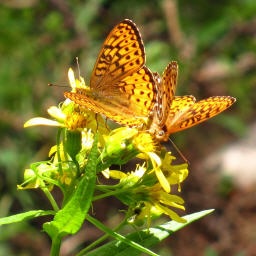
The summer rains have arrived. Yippee! These rains are helpful in so many ways. Perhaps mostly noticeably they provide enough water for the mountain wildflowers to bloom. These flowers coat the hillsides is a glorious canvas of color. The flowers also produce delicious nectar that is enjoyed by many of nature’s creatures. Look carefully and you will see hummingbirds, ants, bees, flies and others feeding on the nectar. When the sun is shining, butterflies are often seen drinking from these fantastic flowers.
What is a Butterfly?
Butterflies are a member of the insect family, and together with moths makeup the order known as ‘Lepidoptera’. The dividing line between butterflies and moths is fairly fuzzy and some creatures could seem to fall into either category. However, the main difference between them is butterflies are generally active in the day and moths are active at night. Also, in a resting position, moths lay their wings down over their bodies, while butterflies stand their wings up so that their undersides may be seen.
Fairly large colorful wings grace the butterfly and give the ability to fly. The large number of yellow winged varieties is probably responsible for the name. The wings seem uniquely designed to help avoid predators, but at the same time to attract mates. Eye patterns in some wings will ward off discerning birds and colorful displays sometimes serve as a warning of bitter flavors to keep away the epicureans. Meanwhile these patterns are recognized by other butterflies of the same species as a call to mate.
Butterflies have a large proboscis, which is actually a mouthpart, and is used to suck nectar and fluids from flowers. While feeding themselves butterflies also serve the function of helping to pollinate flowers.Adult females lay the eggs on a leaf that will become a food source for the new caterpillars. The caterpillars grow bigger and bigger as they eat the leaves. Eventually something is triggered in the caterpillar and it finds aquiet spot to go into its chrysalis phase. The caterpillar does not “build” a chrysalis around itself. Instead, the caterpillar sheds its skin and the chrysalis is underneath.
Their antennae are generally “clubbed” and covered with tiny hairs that also may be found on much of the rest of the body. These hairs tell the butterfly about wind currents, water, vibrations and nearby objects. Butterflies have two compound eyes that see a broad spectrum of light including ultraviolet.
The time lines for (adult) butterflies vary widely, from a few weeks to a couple of years. Some, such as the monarch butterfly actually migrate for various stages and activities. Butterflies also vary widely in size, color and activity.
A butterfly has four stages in its life cycle: egg, larva (caterpillar), pupa (chrysalis) and adult (butterfly). It is a repetitive cycle, but the butterfly does not turn back into an egg!
Like most animals, the male and female adults work together to produce new fertilized eggs.
Adult females lay the eggs on a leaf that will become a food source for the new caterpillars. The caterpillars grow bigger and bigger as they eat the leaves. Eventually something is triggered in the caterpillar and it finds a quiet spot to go into its chrysalis phase. The caterpillar does not “build” a chrysalis around itself. Instead, the caterpillar sheds its skin and the chrysalis is underneath. When the butterfly emerges from its chrysalis, its new wings are fragile. It waits patiently for the wings to dry out and strengthen. Then it flutters away! Many other insects go through similar life cycles.
Colorado Mountain Butterflies and Flowers
There are over 60 species of butterflies in Colorado. Here are some of the more common ones seen in the summer above 8,500 feet and the flowers on which they feed. They vary greatly in size, color and plant food. Read on to learn more about these winged wonders!
Callippe Fritillary – 2 1/8”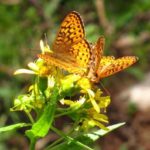
Easier to spot than it is to spell, this butterfly is everywhere from June to August. Their colors fade as they reach the end of their lives.
Favorite flowers: milkweeds, thistles, dogbane, vetch,red clover, cow parsnip
Appropriately named, this butterfly is identified by thespots within its checkered pattern. There are at least 8 species of checkerspots in Colorado and pattern varies within each species.
Favorite flowers: asters, paintbrushes
Western Tiger Swallowtail – 3 1/2”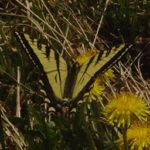
One of the largest butterflies you will see, these are also some of the most common butterflies during June and July.
Favorite flowers: many flowers, including red clover,dandelion and thistles
These little beauties are so small, you might miss them…until you startle them and they flutter away. Look for them in muddy, wet areas. They love moisture.Arrowhead blues are one of many species of blues in Colorado. It is differentiated by a tiny orange arrowhead on the outside bottom of each hind wing.
Favorite flowers: anything in the pea family, especially lupines
Easily mistaken for the larger Tortoiseshell, the Comma has a small comma in the center underside of its hind wing. This butterfly hibernates in winter.
Favorite flowers: varies, includes currants
This butterfly is not as common in this area as the name would imply. Look carefully and you may be fortunate enough to spot one.
Favorite flowers: grasses, cow parsnip, bittercress
All photos copyright MK Gunn 2007 – 2012 unless otherwise noted.
Save the Date!
Want to learn more about butterflies and flowers? MK Gunn is leading a Butterflies and Blooms hike up Cascade Creek on Saturday, July 30th, 9:30am – noon. Details can be found here.
Why do Birds Migrate?
Why do Birds Migrate?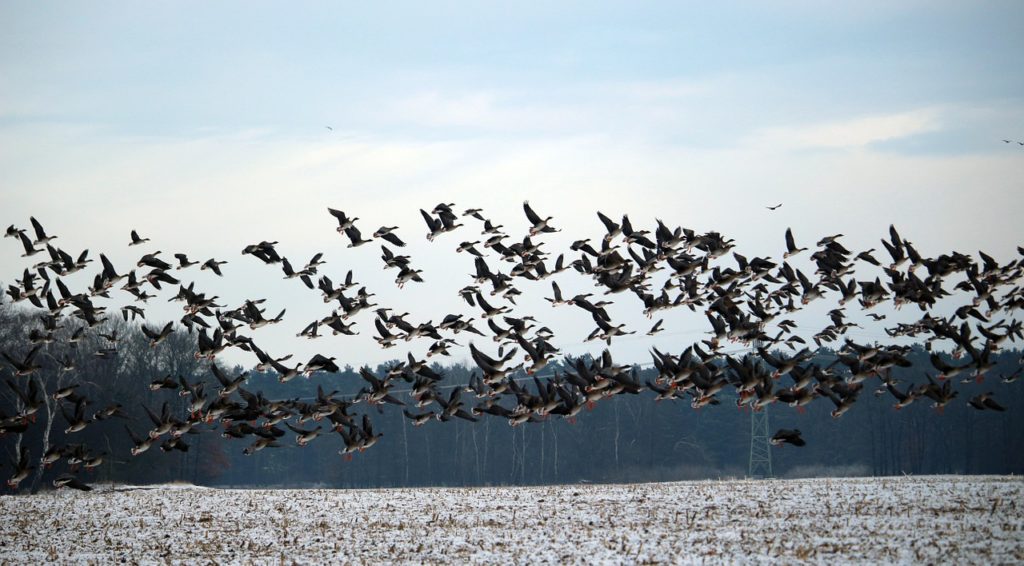
Although many people may associate the timing of bird migration with cold weather, it’s not exactly the cold that makes birds want to move to a different part of the world. Many theories are around trying to explain this phenomenon, from the shortening of the days to hormonal changes. Some scientists have found that changes in the length of daylight affects a gland in some birds’ bodies that produces a hormone that allows their bodies to start storing more fat under their skin, preparing for their long journeys. In the end, though, most birds migrate so that they’ll be able to find food. This is especially true for insectivores, whose food supply of insects either greatly diminishes or completely disappears in the winter. Whatever the reason, something in their bodies triggers the need to migrate, and they must then prepare for the long journey ahead.
Migration – Physical Changes in their bodies
The shape of birds’ bodies assists them in their migration treks across continents. With their streamlined body, hollow bones and well-developed pectoral muscles, not to mention their extremely efficient heart, most birds are literally built to fly long distances. As you can imagine, birds must consume A LOT of food before embarking on their twice a year journey. Small birds will actually double their body weight, while larger birds will increase their weight, but not as much. Building up these fat reserves in small birds allows them to travel for extremely long distances before needing to stop to ‘re-fuel’ – some birds may travel 90 hours before stopping even once! Other birds may migrate for one night, then rest for two or three in an area called a ‘stopover’. These birds may travel as far as 2,000 miles in one night, especially if they have a tail wind. Even tiny hummingbirds migrate. Ruby-throated hummingbirds travel across the ocean from Texas to the Yucatan peninsula, a trip of about 500 miles, without stopping for about 24 hours. Arctic terns fly 22,000 miles roundtrip from the arctic to the Antarctic and back every year!
To help reserve some of their energy, many birds will soar and glide, rather than constantly flapping their wings while migrating. This is especially true for larger birds who can’t store as much energy as the smaller birds. Examples of these birds include eagles, buzzards, and even storks. When hawks migrate together, they are called a ‘kettle’, and you may see them gliding on thermals of air. Thermals are updrafts of air caused by solar heating. One drawback to this method of gliding, however, is that the journey takes longer than if they flapped their wings the entire time.
How do they find their way?
Almost no migrating birds bring their young along to show them their migration route for their first time (although the sandhill crane is one exception). So, at least part of the reason birds migrate, and their knowledge of their migration routes, is instinctual. However, there are still many environmental cues that birds do use to find their way.
Birds often fly along migratory pathways called ‘flyways’. This isn’t necessarily because they like to hang out together, but because they’re all following the same basic clues to get them from point A to point B. The North American flyways include the Pacific, Central, Mississippi, and Atlantic. You can probably guess what they’re following – the Pacific and Atlantic coastlines, the Mississippi river, and the Rocky Mountains (Central flyway). Interestingly, some birds do not take the same route south as they take going north. One possible reason for this may be food availability, although it may also be due to winds at different times of the year.
Many smaller birds migrate at night rather than during the day. This may be because the air masses are more stable, there are fewer predators, and the air is cooler so they have less of a risk of dehydration and overheating. When they are traveling at night, it is speculated that birds may use the stars to navigate, as well as the setting sun. Experiments have been done to demonstrate that birds even use the earth’s magnetic field to set their internal compass and help them find their way north or south. This would be useful especially on overcast days or nights when visibility is low.
Migration Hazards
It has been estimated that half of all migrants that head south in the winter won’t return in the spring. Bird migration has even more challenges than just having enough energy and being able to find their way. They may encounter predation and bad weather along the way. Birds must also deal with the effects that humans have had on the environment. Sometimes the stopovers that birds have typically used may become strip malls, or their fall/winter grounds in the tropical rainforest may have been clear-cut. Many birds also fly into windows during their migration, especially windows on skyscrapers, killing or seriously injuring themselves. To help prevent this, we can break up the reflection of the sky in the windows with awnings or window screens, or by planting trees close to windows or putting bird feeders within a few feet of windows. Our natural areas and public lands, such as those in the San Juan National Forest, and the Tres Rios Resource Area (BLM), provide important habitat for many migratory species.
Fun Facts
• At what heights do most birds migrate? Songbirds travel at less than 5,000 feet, and most of them even stay lower than 2,500 feet. Waterfowl and shorebirds, however, might fly as high as 10,000 to 20,000 feet!
• Songbirds travel about 20 miles/hour, while waterfowl and shorebirds may travel 40 miles/hour or more.
• Birds may migrate together in flocks of the same, or mixed, species, or they may go it alone. Loners might include herons, hummingbirds, kingfishers and woodpeckers, while “flockers” can include ducks, geese, cranes, gulls, doves, crows, jays and blackbirds.
Websites on Bird Migration:
- Bird Sleuth program – students in elementary and middle school use scientific methods to become citizen scientists and study birds: birds.cornell.edu/birdsleuth
- Activity ideas and support materials to help students learn about birds: birds.cornell.edu/schoolyard
- North American flyways: http://www.birdnature.com/flyways.html
- A science education program that uses the internet to track migration – Journey North: www.learner.org/jnorth/
- Published in Animals
Do not disturb wildlife during the cold winter months
What an amazing mid-winter thaw! All this warm weather makes it hard to remember the preceding cold and snowy months of January and December and even early February. The deep snow and bitter cold have made this winter extra tough and stressful for local wildlife.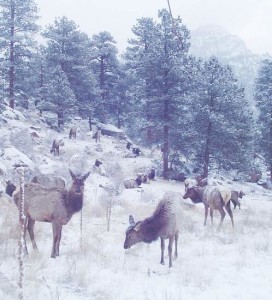
While some animals are hibernating and others have migrated to warmer latitudes, those that have adapted to tolerate the winter have to work harder to stay alive.
Tolerating wildlife have a variety of techniques for surviving the winter. One technique is to yard up. Deer often do this in the deep snow. They create a small network of trails and sleeping areas. They do not stray out of this area into the deep snow, even if they see other food nearby. To do this would risk too much energy. In a particularly harsh winter, animals may run out of food in the yarded area.
As a result of the harsh winter, there will be more winter kill among local wildlife this year. Although this is all part of nature, one can’t help but feel a little sad about starving and frozen critters. The Durango Herald reported back in January that Durango locals have spotted many carcasses near town and even seen mountain lions feeding.
But it doesn’t have to be all doom and gloom. There are measures you can take to help wildlife make it through the winter.
Respect wildlife closure areas. Both the Bureau of Land Management and Colorado Parks and Wildlife manage seasonal closures of public lands. These closures prohibit public access in order to create a less stressful environment for wintering animals, or in some cases, nesting raptors. Starving animals conserve calories by moving as little as possible. Human encroachment from foot travel, biking, motor vehicle use and dogs – even on a leash – can startle wildlife and cause animals to run, therefore using valuable energy stores.
For more information about winter closure areas in Southwest Colorado, including maps, contact the BLM Tres Rios Field Office in Dolores at 882-7296 or Durango at 247-4874, and the CPW Durango office at 247-0855.
Minimize Impact Elsewhere. Animals that live near paved roads, populated areas and ski areas are habituated to noisy humans and are not as stressed by startling sounds. However, winter recreationists – skiers, snowshoers, fat bikers, snowmobilers and even ice climbers – who venture miles away from civilization pose a threat to the survival of wintering animals.
There are a number of studies out there that weigh the effects of noise from different types of human travel in winter. One study showed that deer are more startled by people on foot than snowmobiles. However, snowmobiles do have a greater impact in one way – the weight of snowmobiles causes the snow to collapse, destroying the subnivean underlayers needed by small mammals to survive winter – subnivian meaning “under the snow.” These subnivian creatures create a network of tunnels in the snow and create food caches. It is often much warmer under the snow than out in the open.
Owls are also suffering during this harsh winter. A study on the northern spotted owl showed that a visual disturbance from as far away as 100 meters can disturb the owls.
If you read the Feb. 14 Herald article about the tough winter for wildlife near Glenwood Springs, you are familiar with the fact that there has been an unusual number of dead owls this winter.
This was attributed in part to a lack of small animals above the snow, but human encroachment can also play a part.
So when going into the winter backcountry, think about the creatures that live out there and tolerate the weather all winter long. We humans can choose a warm bed at night, whether we tolerate by heating our house or migrate to southern Arizona and camp out where it is warm.
By MK Gunn
Slippery Ice
As we have experienced in our area recently, ice is a reality in winter. Watching out for ice on the roads and sidewalks practically becomes second nature this time of year, not to mention falling icicles from rooftops! Let’s explore ice properties a bit more – ready for an easy chemistry lesson?
Ice is solid water. In fact, there are 14 known solid phases! Commonly used, the term “ice” refers to the most abundant phase, ice Ih. It is a crystalline solid that you can see through or may be blue-white depending on what is in the air. The addition of materials changes the appearance of ice (particles, sand, dirt, salt, etc). Ice is formed when liquid water is cooled below 32 degrees Fahrenheit or zero degrees Celsius.
When solid, ice is a mineral of hydrogen oxide. Ice is unusual in that it is the only non-metallic substance that expands when it freezes. The solid state of ice is eight percent less dense than liquid water, which is why ice floats. This is an important factor in Earth’s climate – if ice sank, the entire body of water would freeze, killing practically everything in it. The water molecules in ice are packed close together, preventing it from changing shape. Ice has a very regular pattern with the molecules connected by the hydrogen bonds that form a hexagonal pattern. These crystals have a number of open regions and pockets making ice less dense than liquid water. Since ice has a lower density than water, pressure decreases its melting state and can force ice back into liquid water. In the past it was believed that slippery ice is caused by a thin layer of melted water on the ice, due to pressure. Many scientists now believe that the ice molecules that are in contact with the air cannot bond with the molecules of ice beneath – the transition molecules are in a somewhat-liquid state and act as a lubricant. This is not always the case – the extreme South Pole conditions do not make ice and snow slippery.
Ice, snow, hail, frost, and polar ice caps are examples of water in its solid state. Liquid water freezes at 0 degrees Celsius. The ice can then either stay frozen, melt as temperatures climb, or sublimate, turning directly into a vapor. Sublimation occurs naturally with strong sunlight, winds, low relative humidity and low air pressure. It also occurs in frost-free freezers with a fan and air circulation, which keeps a low relative humidity. However, ice cubes also sublimate in this environment, so they may need to be replaced regularly.
Some interesting ice facts:
- 68.7% of the fresh water on earth is stored in ice caps, glaciers and permanent snow
- Glacial ice covers 10-11% of all land.
- 99% of the ice in the world is found in Antarctica and Greenland
- Ice can create erosion by water seeping into rocks and cracking them open when it freezes and expands.
- “Black” ice can form on lakes as well as roadways, and occurs when the ice forms 6-sided, vertically organized columns with few air bubbles. The ice is transparent, and when on roadways looks simply wet, instead of the slippery stuff it is.
Now that you’ve had your chemistry lesson, go out and enjoy your winter, walk carefully, and watch out for that black ice!
By Gabi Morey, Education Outreach Director
- Published in Winter
- 1
- 2



